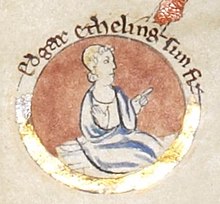Edgar Theling
Edgar Ætheling (* around 1051 ; † around 1125 ) was Anglo-Saxon heir to the throne from the House of Wessex at the time of the Norman conquest of England .
origin
Edgar was the son of Eduard Ætheling . His father, Edgar's grandfather Edmund II. Iron Side, was briefly the Anglo-Saxon King of England in 1016 . After the death of Edmund II and the Danish interregnum, Edmund's brother Eduard the Confessor held the English throne. He died childless in January 1066. Edgar's father Eduard Ætheling had died in 1057. From the rights of his father and grandfather, Edgar was entitled to the throne.
Struggle for supremacy, exile and resistance against the Normans
Edgar was considered too young to face the upcoming invasions of Harald III. of Norway and William II of Normandy (William the Conqueror), who also claimed the English throne. Therefore Edward's brother-in-law Harold Godwinson was elected king by the Witan . Harold was killed in action against the Normans at the Battle of Hastings in October 1066 , after which Edgar of the Witan was elected king. Edgar was unable to stop the Norman invasion and submitted to William by December 1066 at the latest.
In 1069 he tried with Danish support at York to take up the fight against William again, but was defeated and fled to Scotland, where his sister Margaret, King Malcolm III in the same year . of Scotland had married. After Wilhelm’s death in 1087, he supported Wilhelm’s first son, Duke Robert II of Normandy, against his second son, Wilhelm II. Of England, and had to flee again to Scotland in 1091. In Scotland, he helped his nephew Edgar , the Kings Donald III. and overthrow Edmund in 1097 and gain the Scottish royal crown.
First crusade and final years
In 1098 Edgar was in exile in Constantinople . Perhaps he served there in the Varangian Guard of the Byzantine Emperor Alexios I , which at that time consisted largely of Anglo-Saxon Huscarls in exile . In that year Emperor Alexios I gave him a fleet with which he brought supplies, especially building materials and plans for siege engines, to the crusaders of the First Crusade , who were besieging Antioch . He reached the port of St. Symeon with the fleet on March 4, 1098. He then took the city of Latakia, previously conquered by Flemish crusaders, for the Byzantine emperor in possession and left a small garrison there. There are no reports of his continued participation in the crusade.
Back in Europe he fought on the side of Duke Robert II of Normandy in the battle of Tinchebray against King Henry I of England in 1106 and was captured. Thereupon he reconciled himself with Henry I and got an estate in Hertfordshire , where he retired. The daughter of his sister Margaret, Edith of Scotland , had married King Henry I as early as 1100 and thus united the Anglo-Saxon and the Norman lines in her descendants.
Edgar Ætheling died in 1125 or a little later.
literature
- Nicholas Hooper: Edgar the Ætheling. Anglo-Saxon prince, rebel and crusader . In: Peter Clemoes (Ed.): Anglo-Saxon England. Volume 14. Paperback re-issue. Cambridge University Press, Cambridge u. a. 2007, ISBN 978-0-521-03838-6 , pp. 197ff.
Individual evidence
- ↑ See Steven Runciman: History of the Crusades. CH Beck, Munich 2001, p. 216.
- ↑ See Steven Runciman: History of the Crusades. CH Beck, Munich 2001, p. 243.
| personal data | |
|---|---|
| SURNAME | Edgar Theling |
| ALTERNATIVE NAMES | Edgar Aetheling; Edgar Etheling; Edgar Atheling |
| BRIEF DESCRIPTION | Anglo-Saxon heir to the throne |
| DATE OF BIRTH | around 1051 |
| DATE OF DEATH | around 1125 |
